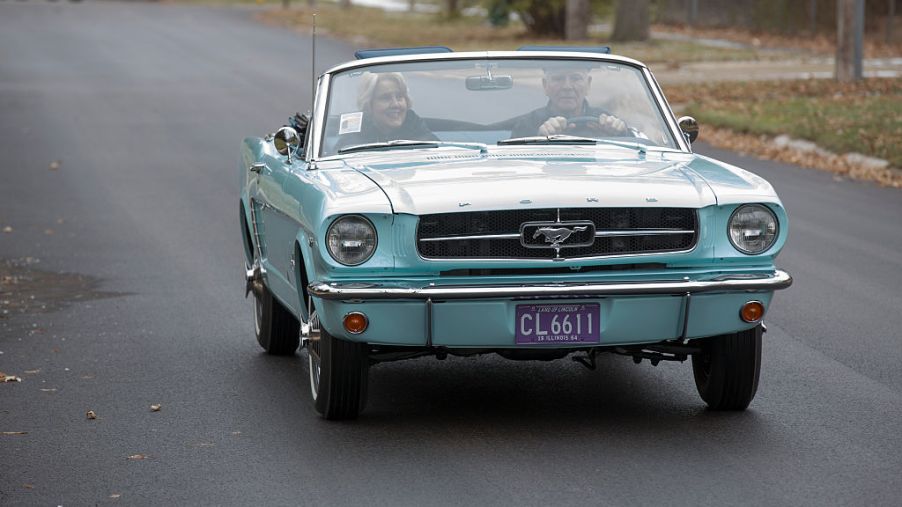
Who Invented the Mustang and When Did It First Debut?
When the first Ford Mustang debuted in 1964, no one could have predicted the reception the four-seat pony car would receive. Envisioned by the new general manager of Ford’s product development division, Lee Iacocca, the hope was that the stylish new car would boost the struggling automaker’s profits. The Ford Mustang did more than that. It turned the American car market on its head.
A smashing debut
Originally projected to sell less than 100,000 units in its first year, the Mustang scored 22,000 sales on its first day. More than a million Mustangs had sold by the end of its second year, launching the era of muscle cars. It also forged a crucial connection with the baby boomer generation.
Engineer Donald Frey developed the Mustang over an 18-month period. While Henry Ford II didn’t approve the project at first, Frey quietly worked under Iacocca’s supervision. When Ford finally approved, it was with the understanding that if the project failed, Frey would lose his job. Fortunately, the Mustang’s unexpected success earned him a promotion. In 1967, he became the vice president of Ford’s North American vehicle development.
When Iacocca became Ford’s general manager, his first goal was to develop a stylish, reasonably-priced sports car. He hoped the right car would help Ford become a strong contender in the American auto market. Producing a car that appealed to the younger baby boomers was a gutsy call that paid off.
The birth of a legend
Iacocca searched through all his team’s car concepts to find the right candidate for his idea. He even sponsored a worldwide contest to find the car design that would later become Ford’s Mustang. In the middle of the search, he ran across a sketch by Gale Halderman who worked for Ford. The design was the “youth car” he’d envisioned. For the next few years, he and his team worked on the development of the Ford Mustang.
They decided the Mustang would seat four passengers instead of two. They also gave the car a short rear deck and a long hood to announce its power and speed. Wider and longer with a bigger engine, the Mustang became the bad boy car of the ’60s.
Iacocca didn’t forget his roots as a salesman and carefully planned Mustang’s unveiling. He selected a time when he wouldn’t run up against any other automakers promoting their vehicles. He selected a venue where he could arrange for heavy media coverage. On April 17, 1964, the debut at the New York World’s Fair was wildly successful.
Ford Mustang through the years
There have been six generations of the Ford Mustang, according to Top Gear. Still in production today, the popular car has experienced both highs and lows throughout the years.
First generation: Built on the Falcon chassis, the Mustang’s first generation lasted through 1973. During that time, it became bigger and heavier. The oil shortage in 1973 and new emissions standards had production boiling the six-cylinder engines down to 88 bhp. Competition came long in the form of the Barracuda, Camaro, and Firebird.
Second generation: Built on the Pinto platform of the time, the second generation Mustangs were far from memorable. These Mustangs weren’t as attractive as their predecessors, handled poorly, and the build quality was lacking. The second generation ended in 1974.
Third generation: The third generation saw the Mustangs become Fox-bodied cars. They were more attractive than the second generation but still an overall step down from the first generation. They produced third generation Mustangs through 1993.
Fourth generation: Made from 1994 to 2004, these Mustangs used an updated Fox platform. Ford got back to business with Mustang’s styling and performance. The Cobra was incredibly popular as was the limited Australian model that had a supercharged 6.8-liter V10 under the hood. This era saw the Mustang get better and better.
Fifth generation: The fifth-generation Mustangs made through 2014 went back to their roots in design and proportion. They used the same contemporary platform used for Lincoln LS and Thunderbird. Mustang gained power and its handling and performance greatly improved.
Sixth generation: The current generation has an independent rear suspension and may be the best class of Mustangs yet. It balances the best of the older and newer models in a car that’s attractive and powerful. Today’s mustangs are what muscle cars are all about.
The legacy of Lee Iacocca
The Ford Mustang became a bigger sensation than Iacocca could have anticipated. On the heels of its debut, media coverage placed the Mustang in newspapers and on TV screens across the United States. It made Iacocca, who was already pretty well-known, a household name. He appeared on the covers of Newsweek and Time. The more he was celebrated, the more Mustangs sold.
In that first year, Ford sold more than 415,000 units. Mustangs even made it into the movies. The same year it debuted, a Ford Mustang convertible was featured in the James Bond film Goldfinger. Years later, in the movie Bullitt, Steve McQueen drove a 1967 Mustang Fastback with a powerful V8 in one of Hollywood’s best car chase scenes.
A second-generation Mustang appeared in the film adaptation of Stephen King’s Cujo, too. The author owned a Mustang II and apparently didn’t like it. The car in the novel and movie broke down, stranding a mother and her young son who are then terrorized by the titular rabid Saint Bernard. But you can’t win them all.
While Iacocca left Ford in the late ’70s, his legacy lived on. After five decades and six generations, the Mustang is still one of America’s favorite cars. It wouldn’t have existed without the determination of Iacocca, who passed away at the age of 95 in July 2019.


